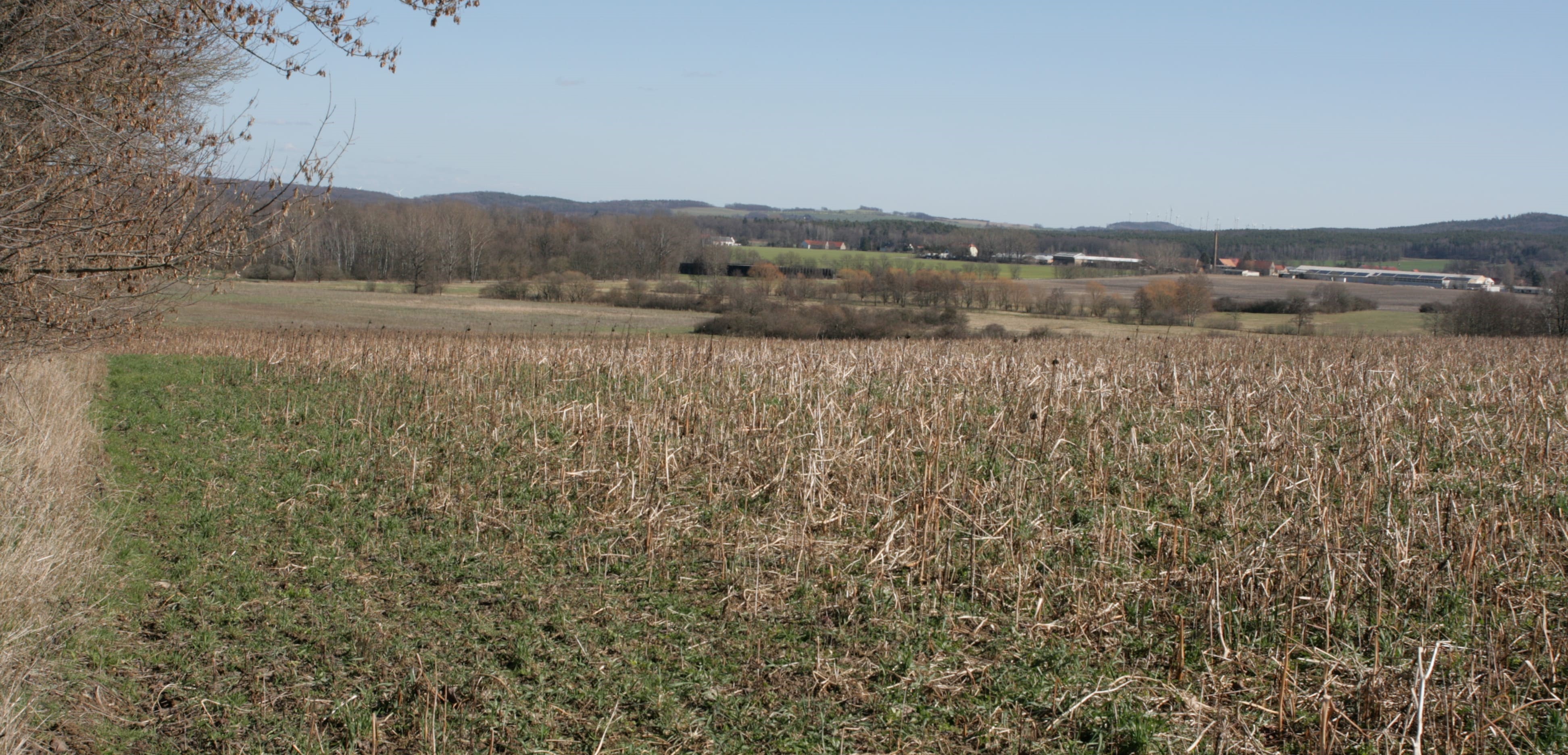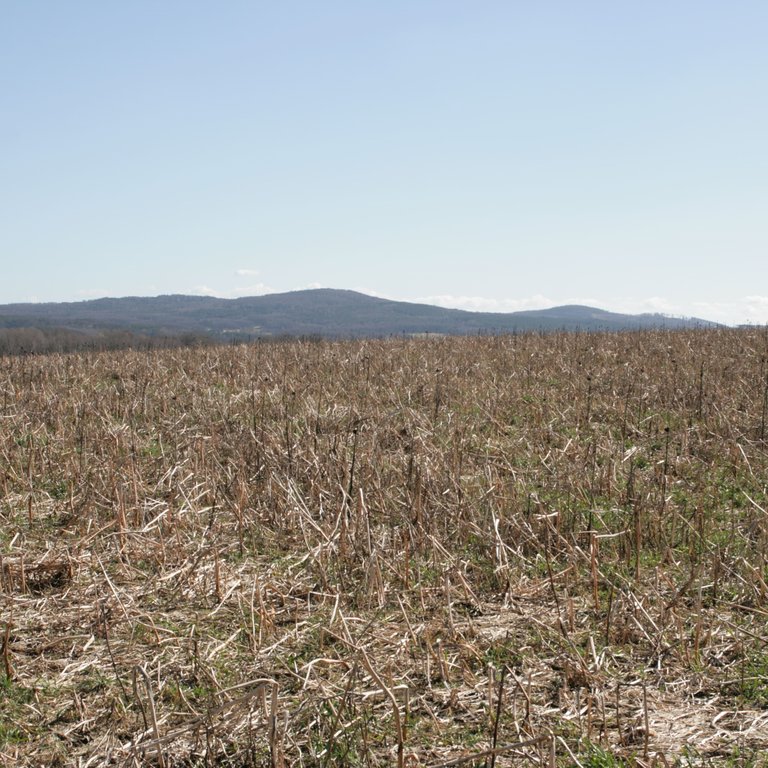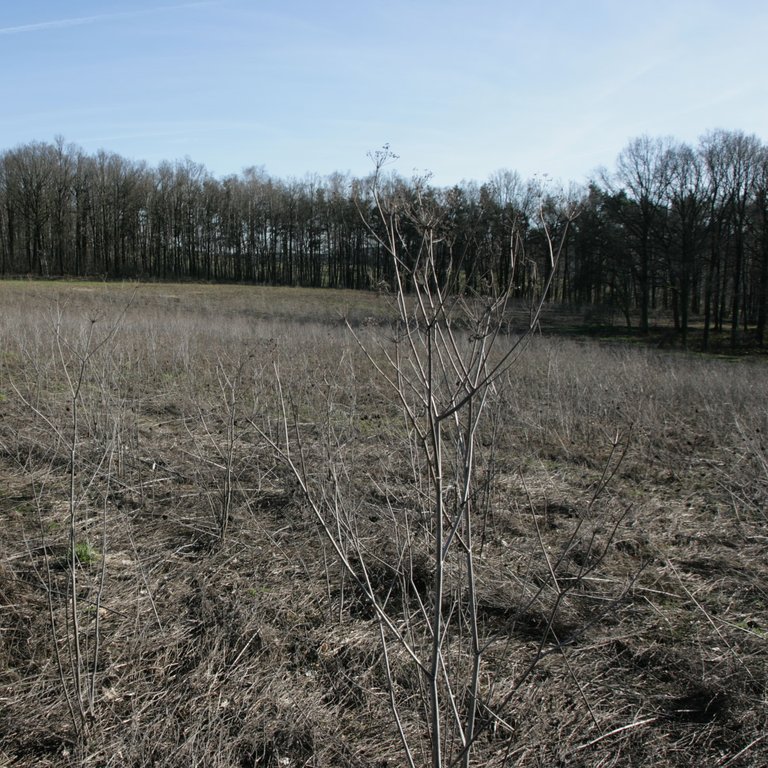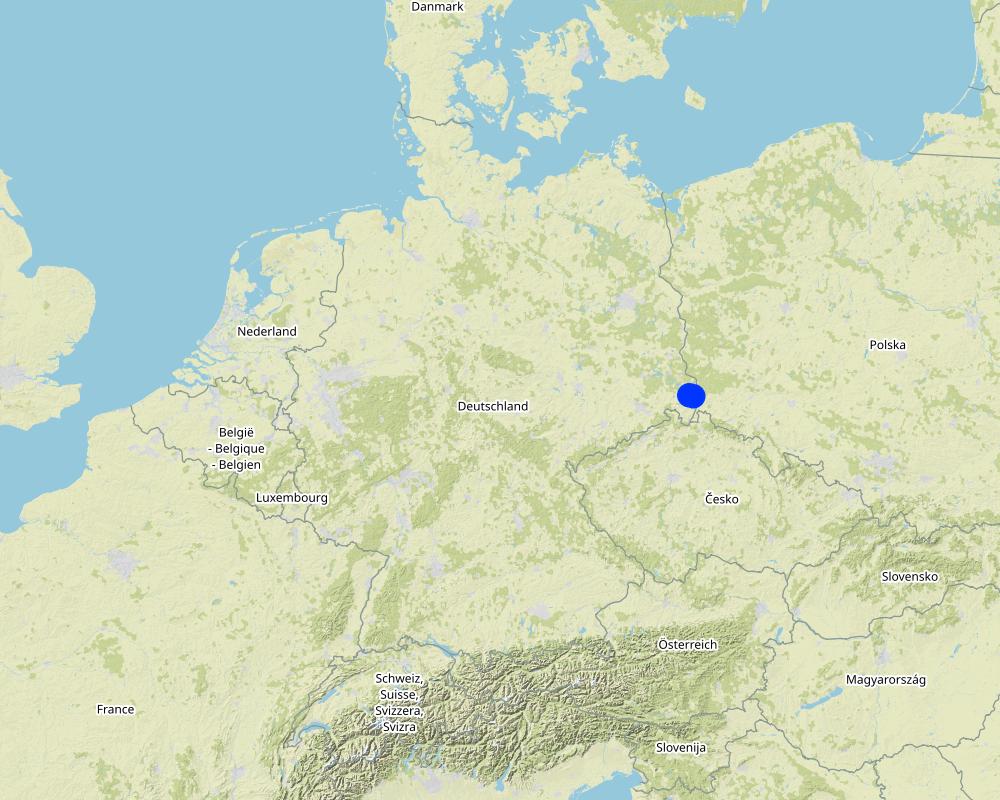Freezing winter cover crops [德国]
- 创建:
- 更新:
- 编制者: Michael Strauch
- 编辑者: Felix Witing, Mona Pauer
- 审查者: William Critchley, Rima Mekdaschi Studer
Abfrierende Zwischenfrüchte
technologies_5929 - 德国
查看章节
全部展开 全部收起1. 一般信息
1.2 参与该技术评估和文件编制的资源人员和机构的联系方式
SLM专业人员:
SLM专业人员:
有助于对技术进行记录/评估的项目名称(如相关)
OPtimal strategies to retAIN and re-use water and nutrients in small agricultural catchments across different soil-climatic regions in Europe (OPTAIN)有助于对技术进行记录/评估的机构名称(如相关)
Helmholtz Centre for Environmental Research (UFZ) - 德国1.3 关于使用通过WOCAT记录的数据的条件
编制者和关键资源人员接受有关使用通过WOCAT记录数据的条件。:
是
1.4 所述技术的可持续性声明
这里所描述的技术在土地退化方面是否存在问题,导致无法被认为是一种可持续的土地管理技术?:
否
2. SLM技术的说明
2.1 技术简介
技术定义:
Freezing winter cover crops are planted to cover the soil rather than for the purpose of being harvested. They improve soil structure, diversify cropping systems, suppress weeds and pests, and prevent nutrient loss.
2.2 技术的详细说明
说明:
In general, cover crops are divided into summer and winter cover crops. They can be used as fodder or as a biogas substrate. However, when left in the field, cover crops support the formation of humus and serve as a source of nutrients for the following crop. Winter cover crops can be divided into winter-hardy and freeze-killed (freezing) cover crops. Choosing the appropriate cover crop depends on its purpose and its position in the crop rotation. Cover crops from the brassica/cruciferous family should be avoided in rotations with oilseed rape (because of increased risk of pests such as clubroot, Sclerotinia or Verticillium), while buckwheat and phacelia are difficult to control in crop rotations with sugar beet. Crops that are used as main crops in a given crop rotation should not be used as cover crops.
Compared to pure stands, mixed stands have the advantage of higher biomass production, rooting density, biodiversity, weed suppression and nutrient availability for the following main crop. Mixed seeds should include at least five types of plant species, including shallow- and deep-rooted species, varieties of freezing and hardy crops that will last over the winter, mycorrhizal species (e.g. phacelia, sunflower) and ruderal species (e.g. legumes, brassica), as well as high growing and soil shading species. Alternatively, monocrops of yellow mustard or oil radish can be grown. However, in this case, ecological benefits are not as high as with mixed stands (LfULG, 2010).
Where appropriate, winter cover crops should be established through direct sowing or mulch sowing. They should be sown immediately after the main crop is harvested (to make maximum use of the remaining growing season and soil moisture). However, delayed sowing (10-14 days) after harvest and stubble cultivation can be beneficial to permit the suppression of weeds and volunteer grain seedlings. Seeding density should be high enough to ensure weed suppression and sufficient biomass development, but not too high, as seed is the main cost of this technology.
To maximize benefits of cover crops, seedbed preparation for the following main crop should be done as late as possible, to avoid mineralization and leaching of nutrients - ideally in combination with the first tillage, for example with the application and incorporation of farm manure at the end of February.
In this documentation we focus on freezing winter cover crops (a mixture of phacelia, buckwheat and sunflower) sown in August/September before the following spring crop (maize). The cover crop is left in the field as ground cover for the winter. It freezes during this period. In spring, the remaining crop residues are worked into the soil by deep tillage. The farmer in our example doesn’t apply this management practice for short-term economic reasons or to fulfill cross-compliance requirements - but rather for the beneficial impact on soil structure, such as reduced bulk density.
2.3 技术照片
2.5 已应用该技术的、本评估所涵盖的国家/地区/地点
国家:
德国
区域/州/省:
Saxony
有关地点的进一步说明:
Kodersdorf
具体说明该技术的分布:
- 均匀地分布在一个区域
如果不知道精确的区域,请注明大致覆盖的区域:
- 0.1-1 平方千米
技术现场是否位于永久保护区?:
否
Map
×2.6 实施日期
注明实施年份:
2017
如果不知道确切的年份,请说明大概的日期:
- 不到10年前(最近)
2.7 技术介绍
详细说明该技术是如何引入的:
- 通过土地使用者的创新
注释(项目类型等):
The farmer decided to apply cover crops to improve soil structure (e.g. reduced bulk density) and diverse its crop rotation.
3. SLM技术的分类
3.1 该技术的主要目的
- 改良生产
- 减少、预防、恢复土地退化
- 结合其他技术保护流域/下游区域
- 保持/提高生物多样性
- 适应气候变化/极端天气及其影响
3.2 应用该技术的当前土地利用类型
同一土地单元内混合使用的土地::
否

农田
- 一年一作
年作 - 具体指明作物:
- 谷类 - 大麦
- 谷物类 - 玉米
- 谷类 - 黑麦
- 谷类 - 小麦(冬季)
- 饲料作物 - 草
每年的生长季节数:
- 1
采用间作制度了吗?:
否
采用轮作制度了吗?:
是
如果是,请具体说明:
Crop rotation: arable grass, (winter cover crop) silage maize, winter wheat,(winter cover crop) silage maize, winter rye, winter wheat, winter barley
注释:
Freezing cover crops are planted in autumn and before the main crop silage maize (spring).
3.3 由于技术的实施,土地使用是否发生了变化?
由于技术的实施,土地使用是否发生了变化?:
- 否(继续问题3.4)
3.4 供水
该技术所应用土地的供水:
- 雨养
3.5 该技术所属的SLM组
- 轮作制度(轮作、休耕、轮垦)
- 改良的地面/植被覆盖
- 土壤肥力综合管理
3.6 包含该技术的可持续土地管理措施

农艺措施
- A1:植被和土壤覆盖层
- A2:有机质/土壤肥力
- A6:残株管理
A6:对残株管理作出具体说明:
A 6.4:保留
3.7 该技术强调的主要土地退化类型

土壤水蚀
- Wt:表土流失/地表侵蚀
- Wg:冲沟侵蚀/沟蚀

土壤风蚀
- Et:表土流失
- Ed:风蚀风积

化学性土壤退化
- Cn:肥力下降和有机质含量下降(非侵蚀所致)

物理性土壤退化
- Pc:压实
- Pk:熟化和结壳
- Ps:有机土壤沉降,土壤沉降

生物性退化
- Bc:植被覆盖的减少
- Bh:栖息地丧失
- Bq:数量/生物量减少
- Bs:质量和物种组成/多样性的下降
- Bl:土壤寿命损失
- Bp:害虫/疾病增加,捕食者减少

水质恶化
- Hs:地表水良变化
3.8 防止、减少或恢复土地退化
具体数量名该技术与土地退化有关的目标:
- 防止土地退化
- 减少土地退化
4. 技术规范、实施活动、投入和成本
4.1 该技术的技术图纸
作者:
Verband der Landwirtschaftskammern 2012 (translated from German into English by Michael Strauch)
日期:
18/03/2022
4.2 有关投入和成本计算的一般信息
具体说明成本和投入是如何计算的:
- 每个技术区域
注明尺寸和面积单位:
1 ha
其它/国家货币(具体说明):
€
如相关,注明美元与当地货币的汇率(例如1美元=79.9巴西雷亚尔):1美元=:
0.91
注明雇用劳工的每日平均工资成本:
18.70€ per hour
4.3 技术建立活动
注释:
there are no establishment activities needed
4.5 维护/经常性活动
| 活动 | 时间/频率 | |
|---|---|---|
| 1. | tillage | autumn, after harvest of preceding crop |
| 2. | sowing | autumn, right after/ a few days after tillage |
| 3. | mulching/seedbed preparation for the main crop | spring, before main crop of the year is planted |
4.6 维护/经常性活动所需要的费用和投入(每年)
| 对投入进行具体说明 | 单位 | 数量 | 单位成本 | 每项投入的总成本 | 土地使用者承担的成本% | |
|---|---|---|---|---|---|---|
| 植物材料 | seeds | ha | 1.0 | 65.4 | 65.4 | |
| 其它 | sowing costs (incl. labour, machinery, diesel) | ha | 1.0 | 68.4 | 68.4 | |
| 技术维护所需总成本 | 133.8 | |||||
| 技术维护总成本,美元 | 147.03 | |||||
如果土地使用者负担的费用少于100%,请注明由谁负担其余费用:
78€/ha were covered by the state of Saxony as a subsidy, AL_4 planting of cover crops (SMUL Sachsen, 2015)
4.7 影响成本的最重要因素
描述影响成本的最决定性因素:
Seeds are the most relevant cost of this technology.
5. 自然和人文环境
5.1 气候
年降雨量
- < 250毫米
- 251-500毫米
- 501-750毫米
- 751-1,000毫米
- 1,001-1,500毫米
- 1,501-2,000毫米
- 2,001-3,000毫米
- 3,001-4,000毫米
- > 4,000毫米
指定年平均降雨量(若已知),单位为mm:
775.00
注明所考虑的参考气象站名称:
https://whh-kliwes.de/mapview
农业气候带
- 半湿润
LGP: 209 (https://www.umwelt.sachsen.de/dauer-der-vegetationsperiode-30631.html)
5.2 地形
平均坡度:
- 水平(0-2%)
- 缓降(3-5%)
- 平缓(6-10%)
- 滚坡(11-15%)
- 崎岖(16-30%)
- 陡峭(31-60%)
- 非常陡峭(>60%)
地形:
- 高原/平原
- 山脊
- 山坡
- 山地斜坡
- 麓坡
- 谷底
垂直分布带:
- 0-100 m a.s.l.
- 101-500 m a.s.l.
- 501-1,000 m a.s.l.
- 1,001-1,500 m a.s.l.
- 1,501-2,000 m a.s.l.
- 2,001-2,500 m a.s.l.
- 2,501-3,000 m a.s.l.
- 3,001-4,000 m a.s.l.
- > 4,000 m a.s.l.
说明该技术是否专门应用于:
- 不相关
5.3 土壤
平均土层深度:
- 非常浅(0-20厘米)
- 浅(21-50厘米)
- 中等深度(51-80厘米)
- 深(81-120厘米)
- 非常深(> 120厘米)
土壤质地(表土):
- 粗粒/轻(砂质)
土壤质地(地表以下> 20厘米):
- 粗粒/轻(砂质)
表土有机质:
- 中(1-3%)
如有可能,附上完整的土壤描述或具体说明可用的信息,例如土壤类型、土壤酸碱度、阳离子交换能力、氮、盐度等。:
cambisol (Braunerde)
5.4 水资源可用性和质量
地下水位表:
< 5米
地表水的可用性:
匮乏/没有
水质(未处理):
不良饮用水(需要处理)
水质请参考::
地表水
水的盐度有问题吗?:
否
该区域正在发生洪水吗?:
否
关于水质和水量的注释和进一步规范:
GWS: -2m
5.5 生物多样性
物种多样性:
- 中等
栖息地多样性:
- 中等
5.6 应用该技术的土地使用者的特征
定栖或游牧:
- 定栖的
生产系统的市场定位:
- 商业/市场
非农收入:
- 低于全部收入的10%
相对财富水平:
- 平均水平
个人或集体:
- 个人/家庭
机械化水平:
- 机械化/电动
性别:
- 女人
- 男人
土地使用者的年龄:
- 中年人
5.7 应用该技术的土地使用者使用的平均土地面积
- < 0.5 公顷
- 0.5-1 公顷
- 1-2 公顷
- 2-5公顷
- 5-15公顷
- 15-50公顷
- 50-100公顷
- 100-500公顷
- 500-1,000公顷
- 1,000-10,000公顷
- > 10,000公顷
这被认为是小规模、中规模还是大规模的(参照当地实际情况)?:
- 大规模的
5.8 土地所有权、土地使用权和水使用权
土地所有权:
- 个人,未命名
土地使用权:
- 租赁
- 个人
用水权:
- 社区(有组织)
土地使用权是否基于传统的法律制度?:
否
5.9 进入服务和基础设施的通道
健康:
- 贫瘠
- 适度的
- 好
教育:
- 贫瘠
- 适度的
- 好
技术援助:
- 贫瘠
- 适度的
- 好
就业(例如非农):
- 贫瘠
- 适度的
- 好
市场:
- 贫瘠
- 适度的
- 好
能源:
- 贫瘠
- 适度的
- 好
道路和交通:
- 贫瘠
- 适度的
- 好
饮用水和卫生设施:
- 贫瘠
- 适度的
- 好
金融服务:
- 贫瘠
- 适度的
- 好
6. 影响和结论性说明
6.1 该技术的现场影响
社会经济效应
生产
作物生产
作物质量
生产故障风险
收入和成本
农业投入费用
农业收入
收入来源的多样性
工作量
生态影响
水循环/径流
地表径流
土壤
土壤水分
注释/具体说明:
reffering to soils in winter
土壤覆盖层
土壤流失
土壤压实
土壤有机物/地下C
生物多样性:植被、动物
外来入侵物种
栖息地多样性
注释/具体说明:
wildlife observed by farmer
害虫/疾病控制
注释/具体说明:
natural pest disease-> increased diversity in crop rotation
减少气候和灾害风险
干旱影响
对现场影响的评估(测量)进行具体说明:
The assessment of on-site impacts is based on the response of the interviewed farmer and not based on on-site measurements.
6.2 该技术的场外影响已经显现
下游洪水
注释/具体说明:
Due to reduced surface runoff.
地下水/河流污染
风力搬运沉积物
注释/具体说明:
Due to improved soil cover.
对场外影响(测量)的评估进行具体说明:
There are no off-site impacts reported by the farmer as they are difficult to assess for him. However, based on expert knowledge of the compiling team, the most relevant off-site impacts that can be expected have been given.
6.3 技术对渐变气候以及与气候相关的极端情况/灾害的暴露和敏感性(土地使用者认为的极端情况/灾害)
渐变气候
渐变气候
| 季节 | 增加或减少 | 该技术是如何应对的? | |
|---|---|---|---|
| 其他渐变气候 | changing weather conditions | 增加 | 好 |
气候有关的极端情况(灾害)
气候灾害
| 该技术是如何应对的? | |
|---|---|
| 热浪 | 好 |
| 干旱 | 好 |
6.4 成本效益分析
技术收益与技术维护成本/经常性成本相比如何(从土地使用者的角度看)?
短期回报:
轻度消极
长期回报:
积极
注释:
No implementation costs, only maintenance costs.
6.5 技术采用
- 1-10%
如若可行,进行量化(住户数量和/或覆盖面积):
72.7 ha
在所有采用这项技术的人当中,有多少人是自发的,即未获得任何物质奖励/付款?:
- 91-100%
注释:
In the past, there have been several subsidy programmes for cover crops. However, these programmes were not continuous and the farmer did thus not adopt the technology because of the payments, but because of the expected benefits of the cover crops.
https://www.landwirtschaft.sachsen.de/anbau-von-zwischenfruechten-und-untersaaten-37212.html
6.6 适应
最近是否对该技术进行了修改以适应不断变化的条件?:
否
6.7 该技术的优点/长处/机会
| 土地使用者眼中的长处/优势/机会 |
|---|
| Improvement of the soil structure. |
| Diversification of the cropping system. |
| 编制者或其他关键资源人员认为的长处/优势/机会 |
|---|
| Reduction of wind and water erosion. |
| Mitigate the loss of soluble nutrients. |
| Suppress weeds and pests. |
6.8 技术的弱点/缺点/风险及其克服方法
| 编制者或其他关键资源人员认为的弱点/缺点/风险 | 如何克服它们? |
|---|---|
| Potential lack of soil moisture in spring because of water use of the cover crops in autumn/winter. | |
| Lack of nutrients because of nutrient uptake by plants in winter. | This weakness only applies to cover crops that are harvested and not to those that are left on the field and incorporated into soil. |
7. 参考和链接
7.1 信息的方法/来源
- 实地考察、实地调查
2
- 与土地使用者的访谈
1
- 根据报告和其他现有文档进行编译
4
(现场)数据是什么时候汇编的?:
16/03/2023
7.2 参考可用出版物
标题、作者、年份、ISBN:
Verband der Landwirtschaftskammern 2012: Zwischenfrüchte für Futternutzung und Gründüngung
可以从哪里获得?成本如何?
https://www.landwirtschaftskammer.de/riswick/pdf/fb-zwischenfruechte-2012.pdf
7.3 链接到网络上的相关信息
标题/说明:
LfULG 2010: Zwischenfrüchte
URL:
https://publikationen.sachsen.de/bdb/artikel/11856/documents/12569
标题/说明:
Gläser (2021): Boden und Gewässerschutz durch Zwischenfruchtanbau
URL:
https://www.landwirtschaft.sachsen.de/download/Merkblatt_Zwischenfruchtanbau.pdf
标题/说明:
Romdhane S, Spor A, Busset H, Falchetto L, Martin J, Bizouard F, Bru D, Breuil M-C, Philippot L and Cordeau S (2019) Cover Crop Management Practices Rather Than Composition of Cover Crop Mixtures Affect Bacterial Communities in No-Till Agroecosystems. Front. Microbiol. 10:1618.
URL:
https://doi.org/10.3389/fmicb.2019.01618
标题/说明:
Messerschmidt (2022): Die Zwischenfrucht muss weg.
URL:
https://www.digitalmagazin.de/marken/agrarheute/magazin/agrarheute-magazin-2022-2/pflanze-technik/118_die-zwischenfrucht-muss-weg
标题/说明:
SMUL Sachsen (2015): Förderperiode 2014-2020-Art. 28 der Verordnung (EU) Nr. 1305/2013 - Richtlinie Agrarumwelt- und Klimamaßnahmen (RL AUK/2015)- Sächsisches Agrarumwelt- und Naturschutzprogramm (AUNaP)
URL:
https://www.smul.sachsen.de/lfulg/download/AUK-Massnahmen-Ueberblick.pdf
链接和模块
全部展开 全部收起链接
无链接
模块
无模块







